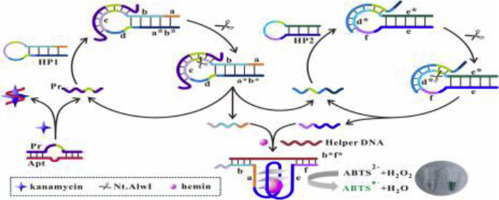当前位置:
X-MOL 学术
›
Anal. Chim. Acta
›
论文详情
Our official English website, www.x-mol.net, welcomes your feedback! (Note: you will need to create a separate account there.)
Low-background and visual detection of antibiotic based on target-activated colorimetric split peroxidase DNAzyme coupled with dual nicking enzyme signal amplification
Analytica Chimica Acta ( IF 6.2 ) Pub Date : 2018-01-01 , DOI: 10.1016/j.aca.2017.10.009 Xuejun Cui , Rongguo Li , Xiaofei Liu , Jingfeng Wang , Xueqi Leng , Xiaolei Song , Qianqian Pei , Yu Wang , Su Liu , Jiadong Huang
Analytica Chimica Acta ( IF 6.2 ) Pub Date : 2018-01-01 , DOI: 10.1016/j.aca.2017.10.009 Xuejun Cui , Rongguo Li , Xiaofei Liu , Jingfeng Wang , Xueqi Leng , Xiaolei Song , Qianqian Pei , Yu Wang , Su Liu , Jiadong Huang

|
Herein, we have reported the development of a simple, rapid, and low cost colorimetric method for the detection of antibiotic based on target-activated split peroxidase DNAzyme coupled with dual nicking enzyme signal amplification (NESA). To lower background signal in G-quadruplex DNAzyme-based detection, the two split G-rich parts are caged into two different hairpin probes, respectively, preventing the two parts from assembling into the G-quadruplex structure. By the combination of restriction endonuclease-assisted cleavage reaction with the spilt G-quadruplex probes, target-modulated release of the two split G-rich parts is achieved, affording high specificity of antibiotic detection. Our strategy features with several aspects. First, the less background signal produced by the self-assembly of G-quadruplex in the absence of target is effectively eliminated owing to the pre-blocking of the two split G-rich parts. Second, dual NESA coupled G-quadruplex DNAzyme amplification strategy is integrated with colorimetric assay of antibiotic, which significantly improves the detection sensitivity. Third, peroxidase-mimicking DNAzyme is used as biocatalyst in our reaction system, which can catalyze the oxidation of 2,2' - azino - bis (3 - ethylbenzothiozoline - 6 - sulfonic acid) (ABTS2-) mediated by H2O2 to generate the colored radical anion (ABTS•-), allowing to low cost and visual detection of antibiotic by the naked eye. Under optimized conditions, the results revealed the proposed biosensor exhibits excellent specificity and sensitivity toward kanamycin with a detection limit as low as 14.7 pM. Hence, the target-activated split G-quadruplex DNAzyme and dual NESA-based strategy provides a useful and practical platform for antibiotic residues determination and other analytes detection in bio-analysis.
中文翻译:

基于靶标激活比色分裂过氧化物酶脱氧核糖核酸酶结合双切口酶信号放大的抗生素低本底目测检测
在此,我们报告了基于目标激活的分裂过氧化物酶 DNA 酶结合双切口酶信号放大 (NESA) 检测抗生素的简单、快速和低成本比色法的开发。为了在基于 G-四链体 DNAzyme 的检测中降低背景信号,将两个分裂的富含 G 的部分分别放入两个不同的发夹探针中,防止这两个部分组装成 G-四链体结构。通过将限制性内切核酸酶辅助切割反应与溢出的 G-四链体探针相结合,实现了两个富含 G 的分裂部分的靶标调节释放,提供了抗生素检测的高度特异性。我们的策略有几个方面的特点。第一的,由于两个富含 G 的分裂部分的预阻断,在没有目标的情况下由 G-四链体自组装产生的较少背景信号被有效地消除。其次,双NESA偶联G-四链体DNAzyme扩增策略与抗生素比色分析相结合,显着提高了检测灵敏度。第三,在我们的反应系统中使用模拟过氧化物酶的 DNAzyme 作为生物催化剂,它可以催化 H2O2 介导的 2,2' - azino - bis (3 -ethylbenzothiozoline - 6 - sulfonic acid) (ABTS2-) 的氧化,产生有色的自由基阴离子(ABTS•-),可以通过肉眼以低成本和视觉检测抗生素。在优化条件下,结果表明,所提出的生物传感器对卡那霉素具有出色的特异性和灵敏度,检测限低至 14.7 pM。因此,目标激活的分裂 G-四链体 DNAzyme 和基于双 NESA 的策略为生物分析中的抗生素残留测定和其他分析物检测提供了有用和实用的平台。
更新日期:2018-01-01
中文翻译:

基于靶标激活比色分裂过氧化物酶脱氧核糖核酸酶结合双切口酶信号放大的抗生素低本底目测检测
在此,我们报告了基于目标激活的分裂过氧化物酶 DNA 酶结合双切口酶信号放大 (NESA) 检测抗生素的简单、快速和低成本比色法的开发。为了在基于 G-四链体 DNAzyme 的检测中降低背景信号,将两个分裂的富含 G 的部分分别放入两个不同的发夹探针中,防止这两个部分组装成 G-四链体结构。通过将限制性内切核酸酶辅助切割反应与溢出的 G-四链体探针相结合,实现了两个富含 G 的分裂部分的靶标调节释放,提供了抗生素检测的高度特异性。我们的策略有几个方面的特点。第一的,由于两个富含 G 的分裂部分的预阻断,在没有目标的情况下由 G-四链体自组装产生的较少背景信号被有效地消除。其次,双NESA偶联G-四链体DNAzyme扩增策略与抗生素比色分析相结合,显着提高了检测灵敏度。第三,在我们的反应系统中使用模拟过氧化物酶的 DNAzyme 作为生物催化剂,它可以催化 H2O2 介导的 2,2' - azino - bis (3 -ethylbenzothiozoline - 6 - sulfonic acid) (ABTS2-) 的氧化,产生有色的自由基阴离子(ABTS•-),可以通过肉眼以低成本和视觉检测抗生素。在优化条件下,结果表明,所提出的生物传感器对卡那霉素具有出色的特异性和灵敏度,检测限低至 14.7 pM。因此,目标激活的分裂 G-四链体 DNAzyme 和基于双 NESA 的策略为生物分析中的抗生素残留测定和其他分析物检测提供了有用和实用的平台。



























 京公网安备 11010802027423号
京公网安备 11010802027423号